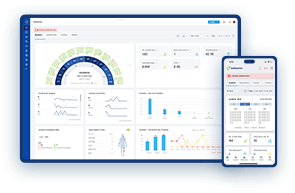
Near Miss Frequency Rate (NMFR): The Key to Proactive Safety
Near misses happen more often than we think. They’re those close calls that could have led to an accident but didn’t—thanks to luck or quick thinking. But just because nothing happened, doesn’t mean we should ignore them. That’s where the Near Miss Frequency Rate (NMFR) comes in.
What is NMFR?
The Near Miss Frequency Rate (NMFR) is a metric that tracks how often these close calls occur in the workplace. It’s like a safety alarm bell, helping you spot potential dangers before they turn into real problems. But it’s more than just a number—NMFR serves as a proactive measure, giving you insight into the hidden risks lurking in your operations. By understanding and monitoring this rate, you can take steps to prevent minor issues from escalating into serious incidents.
Why Should You Care About NMFR?
NMFR isn’t just a number—it’s a way to stay ahead of accidents. By tracking near misses, you can:
Spot Hidden Hazards: Near misses often reveal risks that might go unnoticed until it’s too late. By identifying these hazards early, you can take preventative measures before they cause harm
Boost Safety Culture: When employees report near misses, it shows they’re engaged and aware, making your workplace safer for everyone. Encouraging this behavior fosters an environment where safety is a shared responsibility.
Improve Risk Management: By analyzing near misses, you can identify trends and take action to prevent future incidents. This proactive approach helps in reducing both the frequency and severity of workplace accidents.
How to Calculate NMFR
Calculating NMFR is straightforward:
1. Count the Near Misses: Keep track of all near misses over a set period.
2. Total Work Hours: Record the total hours worked during that time.
3. Apply the Formula:
For example, if you had 10 near misses and 50,000 hours worked, your NMFR would be 40. That means 40 near misses per 200,000 hours worked.
Making NMFR Work for You
Tracking NMFR is just the beginning. To really benefit from it:
Encourage Reporting: Make it easy for employees to report near misses. Anonymity can help if people are hesitant to speak up. With Safetymint’s near miss reporting system, employees can quickly report incidents through the web or mobile, ensuring nothing slips through the cracks.
Dig into the Data: Look for patterns—are there specific times, places, or activities where near misses are more common? By analyzing these patterns, you can target specific areas for improvement and reduce the overall risk.
Take Action: Once you identify a risk, address it quickly. Whether it’s a change in procedure, additional training, or new equipment, the goal is to eliminate the hazard. Acting swiftly not only mitigates the risk but also shows your commitment to safety, building trust among your team.
Challenges in Tracking NMFR
Tracking NMFR isn’t always easy. Some common challenges include:
Underreporting: Employees might not report near misses if they fear blame or don’t see the point.
Data Overload: Without a good system, managing all the reports can become overwhelming.
But with the right approach, these challenges can be overcome. Encouraging a no-blame culture and using digital tools to manage data can make a big difference.
Ready to start tracking NMFR in your workplace? Consider using a safety management software that makes reporting and analyzing near misses easy. The sooner you start, the safer your workplace will become.
Ben Johnson is a dedicated Customer Success Executive at Safetymint. With a strong commitment to excellence, Ben works closely with customers to ensure they fully leverage the capabilities of Safetymint to its fullest potential, aiming to significantly reduce or mitigate safety risks and incidents.




